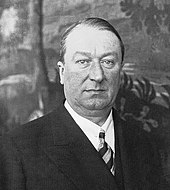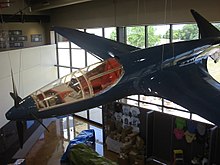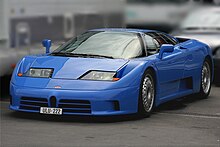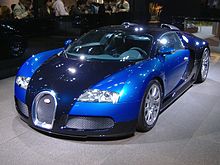Bugatti
This articleneeds additional citations forverification.(October 2009) |
 | |
| Company type | Private |
|---|---|
| Industry | Automotive |
| Founded | 1909 |
| Founder | Ettore Bugatti |
| Defunct | 1963 |
| Fate | Sold toHispano-Suiza(1963)[1] |
| Headquarters | Molsheim,Alsace ,France |
Key people |
|
| Products | Automobiles |
Automobiles Ettore Bugattiwas a German then Frenchmanufacturerofhigh-performance automobiles.The company was founded in 1909 in the then-Germancity ofMolsheim,Alsace,by the Italian-born industrial designerEttore Bugatti.The cars were known for their design beauty and numerous race victories. Famous Bugatti automobiles include theType 35 Grand Prixcars, theType 41 "Royale",theType 57 "Atlantic"and theType 55sports car.
The death of Ettore Bugatti in 1947 proved to be a severe blow to themarque,and the death of his sonJeanin 1939 meant that there was no successor to lead the factory with no more than about 8,000 cars made. The company struggled financially, and it released one last model in the 1950s before eventually being purchased for its airplane parts business in 1963.
In 1987, an Italian entrepreneur bought the brand name and revived it asBugatti Automobili S.p.A.[2]
Under Ettore Bugatti

The founder Ettore Bugatti was born inMilan,Italy, and the automobile company that bears his name was founded in 1909 in Molsheim located in the Alsace region which was part of theGerman Empirefrom 1871 to 1919. The company was known both for the level of detail of its engineering in its automobiles, and for the artistic manner in which the designs were executed, given the artistic nature of Ettore's family (his father,Carlo Bugatti(1856–1940), was an importantArt Nouveaufurniture and jewelry designer).
World War I and its aftermath

During thewarEttore Bugatti was sent away, initially to Milan and later to Paris, but as soon as hostilities had been concluded he returned to his factory at Molsheim.[3]Less than four months after theVersailles Treatyformalised the transfer of Alsace from Germany to France, Bugatti was able to obtain, at the last minute, a stand at the15th Paris motor showin October 1919.[3]He exhibited three light cars, all of them closely based on their pre-war equivalents, and each fitted with the sameoverhead camshaft4-cylinder 1,368cc engine with four valves per cylinder.[3]Smallest of the three was a "Type 13"with a racing body (constructed by the Bugatti themselves) and using a chassis with a 2,000 mm (78.7 in) wheelbase.[3]The others were a "Type 22"and a"Type 23"with wheelbases of 2,250 and 2,400 mm (88.6 and 94.5 in) respectively.[3]
Racing successes

The company also enjoyed great success in earlyGrand Prix motor racing:in 1929, a privately enteredBugattiwon the first everMonaco Grand Prix.Bugatti's racing success culminated with driverJean-Pierre Wimillewinning the24 hours of Le Manstwice (in 1937 withRobert Benoistand in 1939 withPierre Veyron).
Bugatti cars were extremely successful in racing. The littleBugatti Type 10swept the top four positions at its first race. The 1924Bugatti Type 35is one of the most successful racing cars - developed by Bugatti with master engineer and racing driverJean Chassagnewho also drove it in the car's first ever Grand Prix in 1924 Lyon.[4]Bugattis swept to victory in theTarga Floriofor five years straight from 1925 through 1929.Louis Chironheld the most podiums in Bugatti cars, and the modern marque revival Bugatti Automobiles S.A.S. named the 1999Bugatti 18/3 Chironconcept car in his honour. But it was the final racing success at Le Mans that is most remembered—Jean-Pierre Wimille and Pierre Veyron won the 1939 race with just one car and meagre resources.

Aeroplane racing

In the 1930s, Ettore Bugatti got involved in the creation of a racerairplane,hoping to beat the Germans in theDeutsch de la Meurthe prize.This would be theBugatti 100P,[5][6]which never flew. It was designed by Belgian engineerLouis de Mongewho had already applied Bugatti Brescia engines in his "Type 7.5" lifting body.
Railcar
Ettore Bugatti also designed a successful motorised railcar, theAutorail Bugatti.[7]
Family tragedy
The death of Ettore Bugatti's son,Jean Bugatti,on 11 August 1939 marked a turning point in the company's fortunes as he died while testing aType 57 tank-bodied race carnear the Molsheim factory.[8]

After World War II
World War IIleft the Molsheim factory in ruins and the company lost control of the property. During the war, Bugatti planned a new factory at Levallois, a northwestern suburb of Paris. After the war, Bugatti designed and planned to build a series of new cars, including the Type 73 road car and Type 73C single seat racing car, but in all Bugatti built only five Type 73 cars.
Development of a 375 cc supercharged car was stopped when Ettore Bugatti died on 21 August 1947. Following his death, the business declined further and made its last appearance as a business in its own right at aParis Motor Showin October 1952.[9]
After a long decline, the original incarnation of Bugatti ceased operations in 1952.

Design
Bugatti models are known to focus on design.[10]Engine blockswerehand scrapedto ensure that the surfaces were flat so that gaskets were not required for sealing, and many of the exposed surfaces of the engine compartment featuredguillochéfinishes on them. Safety wires were threaded through most fasteners in intricately laced patterns. Rather than bolt the springs to theaxlesas most manufacturers did, Bugatti's axles were forged such that the spring passed through an opening in the axle, a much more elegant solution requiring fewer parts. Bugatti himself described his competitorBentley's cars as "the world's fastest lorries" for focusing on durability. According to Bugatti, "weight was the enemy".[11]
Notable models
| Prototypes | Racing cars | Road cars |
|---|---|---|
|
Gallery
-
1913 Bugatti 22, 3 seat Vinet
-
Bugatti Type 50 i
-
1938Type 57SC Atlanticfrom theRalph Laurencollection
-
Bugatti Type 43 Cockpit
Notable finds in the modern era
Relatives of Harold Carr found a rare 1937 Bugatti Type 57S Atalante when cataloguing the doctor's belongings after his death in 2009. Carr's Type 57S is notable because it was originally owned by British race car driver Earl Howe. Because much of the car's original equipment is intact, it can be restored without relying on replacement parts.[13]
On 10 July 2009, a 1925 Bugatti Brescia Type 22 which had lain at the bottom ofLake Maggioreon the border of Switzerland and Italy for 75 years was recovered from the lake. The Mullin Museum inOxnard, Californiabought it at auction for $351,343 at Bonham'sRétromobilesale in Paris in 2010.
Attempts at revival
The company attempted a comeback under Roland Bugatti in the mid-1950s with themid-enginedType 251race car. Designed with help fromGioacchino Colombo,the car failed to perform to expectations and the company's attempts at automobile production were halted.
In the 1960s,Virgil Exnerdesigned a Bugatti as part of his "Revival Cars"project. A show version of this car was actually built byGhiausing the lastBugatti Type 101chassis, and was shown at the 1965Turin Motor Show.Finance was not forthcoming, and Exner then turned his attention to a revival ofStutz.
Bugatti continued manufacturing airplane parts and was sold toHispano-Suiza,also a former auto maker turned aircraft supplier, in 1963.[1]Snecmatook over Hispano-Suiza in 1968. After acquiringMessier,Snecma merged Messier and Bugatti into Messier-Bugatti in 1977.
Modern revivals
Bugatti Automobili S.p.A. (1987–1995)


Italian entrepreneurRomano Artioliacquired the Bugatti brand in 1987, and establishedBugatti Automobili S.p.A..Artioli commissioned architect Giampaolo Benedini to design the factory which was built inCampogalliano,Modena, Italy. Construction of the plant began in 1988, alongside the development of the first model, and it was inaugurated two years later—in 1990.[14]By 1989, the plans for the new Bugatti revival were presented byPaolo StanzaniandMarcello Gandini,designers of theLamborghini MiuraandLamborghini Countach.
The first production vehicle was theBugatti EB110 GTwhich featured a 3.5-litre, 5-valve per cylinder, quad-turbocharged60°V12 engine,a six-speedgearbox,andfour-wheel drive.Stanzani proposed an aluminium honeycomb chassis, which was used for all early prototypes. He and president Artioli clashed over engineering decisions so Stanzani left the project and Artioli soughtNicola Materazzito replace him in June 1990. Materazzi, who had been the chief designer for theFerrari 288 GTOandFerrari F40replaced the aluminium chassis with a carbon fibre one manufactured by Aerospatiale and also altered the torque distribution of the car from 40:60 to 27:73. He remained Director until late 1992.[15][16] Racing car designerMauro Forghieriserved as Bugatti's technical director from 1993 through 1994.[17]On 27 August 1993, through his holding company, ACBN Holdings S.A. ofLuxembourg,Romano Artioli purchasedLotus CarsfromGeneral Motors.Plans were made to list Bugatti shares on international stock exchanges.
Bugatti presented a prototype large saloon called theEB112in 1993.
Perhaps the most famous Bugatti EB110 owner was seven-timeFormula One World Championracing driverMichael Schumacherwho purchased an EB110 in 1994. Schumacher sold his EB110, which had been repaired after a severe 1994 crash, to Modena Motorsport, a Ferrari service and race preparation garage in Germany.
By the time the EB110 came to market, the North American and European economieswere in recession.Poor economic conditions caused the company to fail and operations ceased in September 1995. A model specific to the US market called the "Bugatti America" was in the preparatory stages when the company ceased operations.
Bugatti's liquidators sold Lotus Cars toProtonof Malaysia. German firmDauer Racingpurchased the EB110 licence and remaining parts stock in 1997 in order to produce five more EB110 SS vehicles. These five SS versions of the EB110 were greatly refined by Dauer. The Campogalliano factory was sold to a furniture-making company, which became defunct prior to moving in, leaving the building unoccupied.[18]After Dauer stopped producing cars in 2011, Toscana-Motors GmbH of Germany purchased the remaining parts stock from Dauer.
Ex vice-president Jean-Marc Borel and ex-employees Federico Trombi, Gianni Sighinolfi andNicola Materazziestablished theB Engineeringcompany and designed and built theEdonisusing the chassis and engine from the Bugatti EB110 SS, but simplifying the turbocharging system and driveline (from 4WD to 2WD).[19]
Bugatti Automobiles S.A.S. (1998–present)
Pre-Veyron

Volkswagen Groupacquired the Bugatti brand in 1998. Bugatti Automobiles S.A.S. commissionedGiorgetto GiugiaroofItalDesignto produce Bugatti Automobiles's first concept vehicle, theEB118,acoupéthat debuted at the 1998Paris Auto Show.The EB118 concept featured a 408-kilowatt(555PS;547bhp), W-18 engine. After its Paris debut, the EB118 concept was shown again in 1999 at theGeneva Auto Showand theTokyo Motor Show.Bugatti introduced its next concepts, theEB 218at the 1999Geneva Motor Showand the18/3 Chironat the 1999Frankfurt Motor Show(IAA).
Veyron era (2005–2015)
Bugatti Automobiles S.A.S. began assembling its first regular-production vehicle, theBugatti Veyron 16.4(the 1001 PS super car with an 8-litre W-16 engine with four turbochargers) in September 2005 at the BugattiMolsheim,France assembly "studio".[20][21]On 23 February 2015, Bugatti sold its last Veyron Grand Sport Vitesse, which was named La Finale.[22]
Chiron era (2016–present)

TheBugatti Chironis amid-engined,two-seated sports car, designed by Achim Anscheidt,[23]developed as the successor to theBugatti Veyron.[24]The Chiron was first revealed at theGeneva Motor Showon March 1, 2016.[25][26]
In February 2024, Bugatti announced the successor to the Chiron, which will use aV16hybrid-electric powertrain.[27]In June of 2024 the successor was confirmed as theBugatti Tourbillon.[28]
See also
- Musée National de l'Automobile de Mulhouse,home of the Schlumpf Collection of Bugatti cars
References
- ^abWood, Jonathan (1992).Bugatti, The Man and the Marque.The Crowood Press. pp. 369–370.ISBN978-1-85223-364-8.
- ^"Michel's Missing Bugatti".Driven To Write.2021-04-01.Retrieved2024-05-24.
- ^abcde"Automobilia".Toutes les voitures françaises 1920 (Salon [Oct] 1919).31.Paris: Histoire & collections: 63. 2004.
- ^L’Automobiliste, 1971 P. 7
- ^"Bugatti Model 100 at the EAA Museum".Retrieved2009-01-28.
- ^"Bugatti Aircraft Association – 100P Airplane".Bugattiaircraft.Retrieved2010-12-31.
- ^Hearst Magazines (December 1934)."Streamlined Auto-Rail Car Used in France".Popular Mechanics.Hearst Magazines. p. 885.
- ^"The birth and too-soon death of Jean Bugatti remembered".ClassicCars Journal.2022-01-15.Retrieved2024-05-24.
- ^"Automobilia".Toutes les voitures françaises 1953 (Salon Paris oct 1952).14.Paris: Histoire & collections: Pages 6 & 10. 2000.
- ^"A closer look at the Bugatti Chiron's design".CNET.Retrieved2024-05-24.
- ^Kew, Ollie."The world's first diesel Bentley is here. And it's fast".Top Gear.
- ^Georgano, G.N.Cars: Early and Vintage, 1886–1930.(London: Grange-Universal, 1985)
- ^"1937 Bugatti Atalante Supercar, One of 17, Found in English Garage, Associated Press, January 2, 2009".The Huffington Post.2009-01-02.Retrieved2011-05-27.
- ^AISA (2011),p. 28.
- ^Barlow, Jason (16 August 2019)."Bugatti Centodieci".Top Gear.Retrieved7 May2020.
- ^Cironi, Davide (15 August 2015)."Edonis e il fallimento Bugatti".Drive Experience. Archived fromthe originalon 2021-10-30.Retrieved7 May2020.
- ^Horst, Jaap."Bugatti EB110 Race Successes".Bugatti Revue.Retrieved7 May2020.
- ^Copyright. Est February 2003."Bugatti on TradeTwentyfourSeven website".Trade-247. Archived fromthe originalon 2012-03-23.Retrieved2010-12-31.
{{cite web}}:CS1 maint: numeric names: authors list (link) - ^Ciferri, Luca (13 December 2005)."B Engineering".Autonews.Retrieved7 May2020.
- ^"Bugatti: 1,001 horsepower, $1.24 million".CNN.2005-09-16.Retrieved2012-07-28.
- ^"Manufacturing the Veyron".Bugatti Automobiles S.A.S. 2011-11-30. Archived fromthe originalon 2013-07-19.Retrieved2012-07-28.
- ^Sorokanich, Robert (23 February 2015)."The very last Bugatti Veyron has been sold".Road and Track.Retrieved23 February2015.
- ^Wewer, Antje."Porsche Achim Anscheidt, B AA 9117 H".Porsche AG – Dr. Ing. h.c. F. Porsche AG.Retrieved2016-10-03.
- ^Branman, Miles (2015-11-24)."Bugatti's world-challenging Chiron supercar will let you take its roof off".Digital Trends.US.Retrieved2016-10-28.
- ^Taylor, James (2016-02-29)."Bugatti Chiron revealed at Geneva 2016: the world has a new fastest production car".CAR Magazine.UK.Retrieved2016-03-23.
- ^"2016 Geneva Auto Show – Auto Show".Car and Driver.US.Retrieved2016-03-23.
- ^"Official: Bugatti Chiron replacement to swap W16 engine for V16".Autocar.Retrieved2024-03-01.
- ^Communications, Bugatti (2024-06-21)."The Bugatti Tourbillon: an automotive icon 'Pour l'éternité' – Bugatti Newsroom".newsroom.bugatti.Retrieved2024-06-21.
- Benedini, Giampaolo;Artioli, Romano."Un progetto nello spirito Bugatti"; "Quasi un sacrilegio"(PDF).Bugatti in Italia;Schio,Milan,12 November 2011.Associazione Italiana per la storia dell'automobile, conference 100(in Italian). AISA.Archived(PDF)from the original on 2022-10-09.
External links
- Bugatti
- Car manufacturers of France
- Companies based in Grand Est
- Vehicle manufacturing companies established in 1909
- Vehicle manufacturing companies disestablished in 1963
- Defunct aircraft engine manufacturers of France
- Defunct companies of France
- Formula One constructors
- Formula One entrants
- French auto racing teams
- French racecar constructors
- Grand Prix teams
- Auto racing teams established in 1929
- Auto racing teams disestablished in 1956
- Luxury motor vehicle manufacturers
- Sports car manufacturers
- Volkswagen Group
- Molsheim
- Car brands
- German companies established in 1909
- 1963 disestablishments in France





